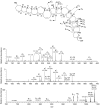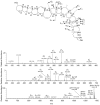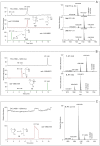LC-HRMS and Chemical Derivatization Strategies for the Structure Elucidation of Caribbean Ciguatoxins: Identification of C-CTX-3 and -4
- PMID: 32244322
- PMCID: PMC7230550
- DOI: 10.3390/md18040182
LC-HRMS and Chemical Derivatization Strategies for the Structure Elucidation of Caribbean Ciguatoxins: Identification of C-CTX-3 and -4
Abstract
Ciguatera poisoning is linked to the ingestion of seafood that is contaminated with ciguatoxins (CTXs). The structural variability of these polyether toxins in nature remains poorly understood due to the low concentrations present even in highly toxic fish, which makes isolation and chemical characterization difficult. We studied the mass spectrometric fragmentation of Caribbean CTXs, i.e., the epimers C-CTX-1 and -2 (1 and 2), using a sensitive UHPLC-HRMS/MS approach in order to identify product ions of diagnostic value. We found that the fragmentation of the ladder-frame backbone follows a characteristic pattern and propose a generalized nomenclature for the ions formed. These data were applied to the structural characterization of a pair of so far poorly characterized isomers, C-CTX-3 and -4 (3 and 4), which we found to be reduced at C-56 relative to 1 and 2. Furthermore, we tested and applied reduction and oxidation reactions, monitored by LC-HRMS, in order to confirm the structures of 3 and 4. Reduction of 1 and 2 with NaBH4 afforded 3 and 4, thereby unambiguously confirming the identities of 3 and 4. In summary, this work provides a foundation for mass spectrometry-based characterization of new C-CTXs, including a suite of simple chemical reactions to assist the examination of structural modifications.
Keywords: Gambierdiscus; HRMS; LC–MS; Scomberomorus cavalla; Sphyraena barracuda; ciguatera; ciguatoxin; fragmentation pathways; ladder-frame molecule; polyether toxin.
Conflict of interest statement
The authors declare no conflict of interest.
Figures






Similar articles
-
Reductive Amination for LC-MS Signal Enhancement and Confirmation of the Presence of Caribbean Ciguatoxin-1 in Fish.Toxins (Basel). 2022 Jun 9;14(6):399. doi: 10.3390/toxins14060399. Toxins (Basel). 2022. PMID: 35737060 Free PMC article.
-
Ciguatera Fish Poisoning in the Caribbean Sea and Atlantic Ocean: Reconciling the Multiplicity of Ciguatoxins and Analytical Chemistry Approach for Public Health Safety.Toxins (Basel). 2023 Jul 10;15(7):453. doi: 10.3390/toxins15070453. Toxins (Basel). 2023. PMID: 37505722 Free PMC article. Review.
-
Liquid Chromatography Coupled to High-Resolution Mass Spectrometry for the Confirmation of Caribbean Ciguatoxin-1 as the Main Toxin Responsible for Ciguatera Poisoning Caused by Fish from European Atlantic Coasts.Toxins (Basel). 2020 Apr 21;12(4):267. doi: 10.3390/toxins12040267. Toxins (Basel). 2020. PMID: 32326183 Free PMC article.
-
Algal ciguatoxin identified as source of ciguatera poisoning in the Caribbean.Chemosphere. 2023 Jul;330:138659. doi: 10.1016/j.chemosphere.2023.138659. Epub 2023 Apr 10. Chemosphere. 2023. PMID: 37044143 Free PMC article.
-
Detection of pacific ciguatoxins using liquid chromatography coupled to either low or high resolution mass spectrometry (LC-MS/MS).J Chromatogr A. 2018 Oct 12;1571:16-28. doi: 10.1016/j.chroma.2018.08.008. Epub 2018 Aug 4. J Chromatogr A. 2018. PMID: 30100527 Review.
Cited by
-
In Vitro Glucuronidation of Caribbean Ciguatoxins in Fish: First Report of Conjugative Ciguatoxin Metabolites.Chem Res Toxicol. 2021 Aug 16;34(8):1910-1925. doi: 10.1021/acs.chemrestox.1c00181. Epub 2021 Jul 28. Chem Res Toxicol. 2021. PMID: 34319092 Free PMC article.
-
Automatic MS/MS Data Mining Strategy for Rapid Screening of Polyether Toxins Derived from Gambierdiscus Species.Anal Chem. 2025 Mar 18;97(10):5643-5652. doi: 10.1021/acs.analchem.4c06440. Epub 2025 Mar 4. Anal Chem. 2025. PMID: 40035825 Free PMC article.
-
Comparison of Different Solid-Phase Cleanup Methods Prior to the Detection of Ciguatoxins in Fish by Cell-Based Assay and LC-MS/MS.J Agric Food Chem. 2025 Jun 11;73(23):14580-14591. doi: 10.1021/acs.jafc.5c01142. Epub 2025 Jun 1. J Agric Food Chem. 2025. PMID: 40452308 Free PMC article.
-
Critical Review and Conceptual and Quantitative Models for the Transfer and Depuration of Ciguatoxins in Fishes.Toxins (Basel). 2021 Jul 23;13(8):515. doi: 10.3390/toxins13080515. Toxins (Basel). 2021. PMID: 34437386 Free PMC article. Review.
-
3-Epimers of Caribbean ciguatoxins in fish and algae.Toxicon. 2024 Jan;237:107536. doi: 10.1016/j.toxicon.2023.107536. Epub 2023 Dec 2. Toxicon. 2024. PMID: 38043714 Free PMC article.
References
-
- Friedman M.A., Fernandez M., Backer L.C., Dickey R.W., Bernstein J., Schrank K., Kibler S., Stephan W., Gribble M.O., Bienfang P., et al. An updated review of ciguatera fish poisoning: Clinical, epidemiological, environmental, and public health management. Mar. Drugs. 2017;15:72. doi: 10.3390/md15030072. - DOI - PMC - PubMed
-
- Yasumoto T., Murata M. Marine Toxins. Chem. Rev. 1993;93:1897–1909. doi: 10.1021/cr00021a011. - DOI
-
- Kohli G.S., Campbell K., John U., Smith K.F., Fraga S., Rhodes L.L., Murray S.A. Role of modular polyketide synthases in the production of polyether ladder compounds in ciguatoxin-producing Gambierdiscus polynesiensis and G. excentricus (Dinophyceae) J. Eukaryot. Microbiol. 2017;64:691–706. doi: 10.1111/jeu.12405. - DOI - PubMed
MeSH terms
Substances
Grants and funding
LinkOut - more resources
Full Text Sources
Research Materials

